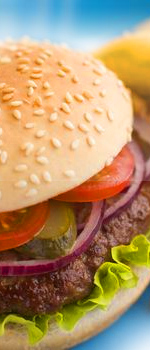
|
Follow Me On: |
 |
Derek Egeberg - NMLS#180899 Branch Manager, Loan Officer Guild Mortgage (NMLS 3274) Phone: (928) 247-9089 License: BK 0915245 derek.egeberg@guildmortgage.net www.guildyuma.com |
 | ||
| ||||
September 2009

|
Burger Meister Mastering the World’s Most Perfect Sandwich By Kirk Leins
When you think of American cuisine, the dish that most likely comes to mind first is the hamburger. It's not only the most iconic foodstuff our country has to offer, when done right it is also one of the most delicious and satisfying meals you can eat with your hands. With Labor Day quickly approaching, it's safe to say that many of you are in the midst of planning a daytime cookout or barbecue. Whether or not you've decided on your menu, I highly urge you to consider making burgers a part of it. In order to fully understand my conviction, we need to first brush up on a little burger history. Hamburger History The notion of eating ground or finely minced beef patties dates back to ancient Egypt. The patty's journey toward becoming a hamburger, however, seems to have begun when Genghis Kahn started utilizing their portability in the latter part of the 12th century, having villagers form scraps of raw meat so his soldiers could eat on the go. Genghis' grandson, Kublai Kahn, invaded Russia in the 13th century, bringing the meat patties along with him. The patties were adapted into Russian cuisine and became known as steak tartare. At some point between the 1300s and 1600s, via cargo ships passing between Russia and Europe, the patties made the journey into Hamburg, Germany. Due to the resulting tenderization, grinding or mincing beef quickly became popular with less affluent Germans, who only had access to cheaper cuts of meat. These working class folk eventually began flavoring the meat with regional spices, as well as cooking the patties. Within Hamburg this dish (in both its raw and cooked form) became known as Hamburg steak. By the 1800s, German immigrants arriving in America brought the idea of Hamburg steak along with them. It is said that the idea first caught on with street vendors who would recreate the dish in order to attract German customers. But by 1834, the cooked version of Hamburg steak had become so popular it actually made it onto the dinner menu of the famed New York restaurant, Delmonico's. There are several stories as to who first put the cooked meat patty between bread and called it a hamburger. One of the more popular versions is that in 1855 two food vendors, brothers Charles and Frank Menches ran out of pork sausage patties during a fair in Erie County, New York. They substituted the sausage with patties of cooked ground beef. As an homage to their host city of Hamburg, New York, they dubbed their creation the hamburger. So, what have we learned here? While the hamburger has since evolved into a potentially wild concoction, oftentimes consisting of various types of meat and anything from standard to exotic accoutrement, its origins are quite meager to say the least. Furthermore, throughout the hamburger's early years it was always more about the meat than anything else. Do you see where I'm going with this? Where's the Beef? Instead, I suggest finding a local butcher shop, either privately owned or within a larger market, willing to grind your beef fresh while you wait. Trust me when I say it will make a huge difference in the quality of your burger. While there are many different cuts of beef that can be used in a hamburger, two that are accessible, affordable, and serve very specific purposes are chuck and sirloin. Meat cut from the chuck primal is what gives a burger the proper fat content, resulting in succulence and optimal texture. Sirloin, on the other hand, is all about the deep and rich flavor. I like using a 50/50 blend of the two cuts and here's how I go about it. I walk into my favorite local butcher and search the case for a chuck roast with a decent fat content. The size of the roast I choose depends on the amount of people I'm serving. Next, I find the same amount (in weight) of either choice or prime sirloin steak. I then ask the butcher to coarsely grind them together for me. The result is perfect meat for making hamburgers. Feel free to play with the ratio of the two cuts in order to suit your own taste. Before we actually make burgers I would like to say that if a butcher shop gives you a hard time about freshly grinding your meat, you may want to question your patronage. After all, you are paying the going price for each cut. The only difference is you are asking to control the ratio and have it ground fresh. It should be no problem for them to accommodate you. There are times, however, that I'm not able to buy my freshly ground meat on the day I want to use it. In this situation, I will purchase my chuck roast and sirloin steak(s) the day before, and then grind them at home the day of. I simply cut all the meat into one-inch cubes and toss to combine. Using a food processor, I work in batches and use a series of one-second pulses until the meat resembles coarsely ground hamburger. This method works really well. Beef Lover's Burger (makes 6 burgers)
Place the meat into a large bowl and add salt. Mix until just combined and lightly form the meat into 6 equal-sized patties, 1 to 1.25-inches thick. Make sure to form your patties roughly the same size diameter as the bun. Using three fingers, make a slight indentation into the center of each patty. This will help them from puffing up into baseballs during cooking. In a medium stainless-steel saucepot, heat 3 tbsp canola oil until it's quite hot. Add the onions and season with salt and pepper. Let the onions sit for a few minutes before stirring. Turn the heat down slightly and allow the onions to sauté for 15 to 20 minutes, occasionally stirring. Once the onions are mostly browned, add the balsamic vinegar, being very careful to avert your face from the pot to avoid the resulting fumes. Mix to combine and taste; re-season if necessary. Cover and keep warm until serving. Heat a cast iron skillet over a very high heat. Add 3 tbsp bacon drippings or cooking oil. Once it starts giving off wisps of smoke add the burgers and turn down the heat just a touch. Cook for 3 to 3.5 minutes on each side for medium/medium-rare. Remove the burgers from the pan, top with cheese slices and allow them to rest for 5 minutes. Place the burger on the buns and top with equal portions of the caramelized onions. Enjoy. Note that this recipe can also be prepared on a gas grill or charcoal barbecue. If doing so, bacon drippings and cooking oil are NOT needed for the burgers. So, now that you have my recipe for a beef lover's burger, how about a few recipes to go with it? For starters, I would like to point you toward the June 2008 issue of YOU Magazine and look for my article titled Summer Cookouts. In there you will find recipes for the Leins Family's Potato Salad, my Compromise Cole Slaw, Macaroni Salad, and Easy Baked Beans. Each of these four recipes would be awesome served alongside my burgers. In the spirit of loading you up with recipes for Labor Day, here's an incredible cucumber salad. And yes, it's also the perfect accompaniment to the burgers. Summer Cucumber Salad
In a small bowl, add vinegar and oil and season liberally with salt and pepper. Whisk to combine and set aside. In a large bowl, combine cucumber, tomatoes, and basil leaves. Season the mixture with salt and pepper. Give the dressing a stir and add it to the vegetable mixture. Toss to combine. Allow the salad to sit at room temperature for 15 to 30 minutes before serving. Toss again and garnish with crumbled feta cheese. I'm being honest when I say I truly feel I've done my duty here. Your job now is to recreate a few of these dishes and serve them proudly at your Labor Day party. After all, you've been working hard all year. You deserve a fun day!
| ||||||||||||||||||||||||||||||
LO# 0915245 BK# 0904081 Corp NMLS# 3113 Corp CA# 4170013 CA-DOC180899 Licensed by the Department of Business Oversight under the California Residential Mortgage Lending Act. You are receiving a complimentary subscription to YOU Magazine as a result of your ongoing business relationship with Derek Egeberg - NMLS#180899. While beneficial to a wide audience, this information is also commercial in nature and it may contain advertising materials. INVITE A FRIEND to receive YOU Magazine. Please feel free to invite your friends and colleagues to subscribe. SUBSCRIBE to YOU Magazine. If you received this message from a friend, you can subscribe online. UNSUBSCRIBE: If you would like to stop receiving emails from Derek Egeberg - NMLS#180899, you can easily unsubscribe. Guild Mortgage (NMLS 3274) |
1375 W. 16th St., Suite B Yuma, AZ 85364 Powered by Platinum Marketing © Copyright 2024. Vantage Production, LLC. | |||||||||



 Kirk Leins has been cooking his entire life. No stranger to professional kitchens, he currently devotes most of his time to cooking instruction, food writing, and producing television. Kirk also provides his services as a personal chef in and around the Los Angeles area. He has made several TV appearances on both the national and local level, and is the Executive Chef for YOU Magazine. Sign up for Kirk's free newsletter and cooking blog at
Kirk Leins has been cooking his entire life. No stranger to professional kitchens, he currently devotes most of his time to cooking instruction, food writing, and producing television. Kirk also provides his services as a personal chef in and around the Los Angeles area. He has made several TV appearances on both the national and local level, and is the Executive Chef for YOU Magazine. Sign up for Kirk's free newsletter and cooking blog at